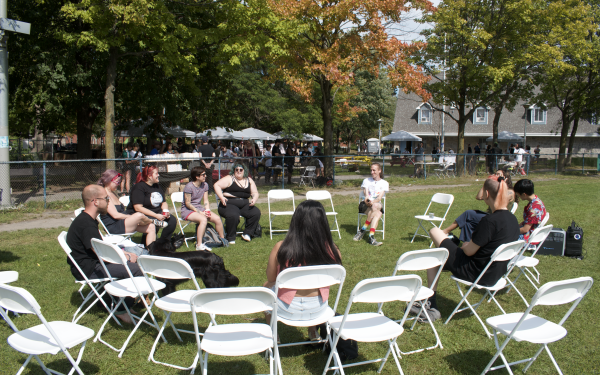Understanding the path to drug decriminalization
The complexities of drug reform in B.C. and what it means for Canada’s future
A study in Drug and Alcohol Review found that drug-related mortality rates in Quebec have surged since 2012, with opioid deaths peaking at 2.7 per 100,000 people in 2020. As fatalities rise, the push for drug decriminalization has gained momentum across Canada.
On Jan. 31, 2023, British Columbia (B.C.) became the first Canadian province to decriminalize the use of certain illicit drugs in approved locations for personal use such as opioids, cocaine, meth and ecstasy with a combined carrying limit of 2.5g.
Health Canada allowed the province a three-year exemption to the Controlled Drugs and Substances Act with the goal of “[reducing] stigma and fear of criminal prosecution that prevents people from reaching out for help, including medical assistance.”
According to the B.C. government and the BC Centre for Disease Control (BCCDC), the original intent behind implementing the decriminalization policy was to move to a public health-centred approach instead of a criminal justice approach. The policy outlined several goals such as focusing on improving community connectedness, increasing the use of safe drug-related services and the destigmatization of drug users, with the province stressing addiction is a health issue, not a criminal one.
“The original push for decriminalization, believe it or not, came from the police,” said Dr. Kennedy Stewart, professor at Simon Fraser University and former mayor of Vancouver. “If you find somebody with drugs, you arrest them, you put them through courts, you go to all the expense of this and all the personal harm, and then nothing really happens. They don't go to jail. They definitely don't get medical help. So the police saw this as a health-related issue.”
Not all illicit drugs have been decriminalized in B.C., and the policy includes specific constraints related to the context and environment of drug use, such as restrictions on consumption in public spaces.
Beyond government discourse, many individuals have questioned the effectiveness of current drug policies in Canada outside of B.C., where drugs are not yet decriminalized.
Montreal resident Malik Omar told The Link he believes that people can still access drugs despite criminalization, explaining that the latter only puts consumers in legal predicaments.
Canada’s approach to drug regulation began in the early 20th century, with opiates and cocaine becoming illegal in 1911, followed by the prohibition of cannabis in 1923.
“I don’t think the government should be criminalizing drugs at all,” Omar said. “They don’t seem to care about [harmful products and foods on the market], but they for some reason care about this one thing called ‘drugs’ which is a blanket statement.”
Initially, B.C.’s policy did not exclude public spaces. But as of May 7, 2024, the government of B.C. amended the decriminalization policy to “exempt public spaces [...] effective immediately” following an increase in drug use in spaces such as hospitals and parks.
Since then, the policy has only applied to private spaces such as shelters and residences, as well as safe consumption sites, overdose prevention sites, drug checking sites and addiction services locations.
When asked whether he would support a similar decriminalization policy in Quebec, Montreal resident Tristan Lepage reflected on its potential benefits while acknowledging its complexity. He noted that, although concerns exist about incentivizing drug use, “if it’s controlled well and there’s education with how this is handled, it could be a huge benefit to society.”
Lepage also said that he believes decriminalization would encourage more people to seek the help they need.
In the first quarter of 2024 alone, 81 per cent of opioid-related deaths in Canada involved fentanyl.
“It is the number one killer of young people in B.C. by far,” Dr. Stewart said. “Fentanyl is so cheap to produce. It was a little trickier when it was imported, but now that it's being produced domestically, it is just totally entrenched in our system.”
The Canadian government emphasizes on its website that stigma is a major contributor to overdoses, asserting that addiction is not a choice but a treatable solution—an assertion that decriminalization directly supports.
According to the BCCDC, since the implementation of B.C.’s policy last year, drug-related offences have decreased significantly, with a reported 77 per cent drop in possession offences within the first nine months.
“[Decriminalization] reduces the tendency for risky behaviour among drug users and helps steer them toward different health options, whether it's a safer supply or what we call an opioid agonist therapy, which will help them reduce their cravings,” Dr. Stewart said.
Despite these successes, the drug supply in B.C. remains largely unregulated and highly toxic, particularly with fentanyl driving the ongoing crisis. Government documents emphasize the distinction between decriminalization and legalization, highlighting that decriminalization aims to facilitate access to support and ensure safer drug use.
“What people get confused between is legalization and decriminalization,” Dr. Stewart said. “They’re actually very different things [...] decriminalization means if you're in possession of these drugs, you are not liable for criminal prosecution. So that's where the grey area happens. It's still illegal to produce these drugs, it's still illegal to sell these drugs. It's just not illegal to hold these drugs or consume these drugs. And that's a big difference.”
To legalize drugs would mean that they would be able to be produced, owned, consumed, and sold according to regulations and without legal repercussions.
One year after the policy’s implementation, the Canadian Institutes of Health Research surveyed individuals who used illegal drugs after the decriminalization policy was in place to assess the impact and perception of decriminalization.
Overall, the results indicate that people who use drugs “are [now] less concerned about being arrested and feel more comfortable carrying substances they need.”
“Securing illicit drugs is risky behaviour,” Dr. Stewart said. “When you throw the police in on top of this, what it tends to do when people are using [is] push them into secluded spaces. So they're often using alone.”
Dr. Stewart described the impact of drug seizures before drugs were decriminalized in B.C., noting that “if [authorities] found you with drugs, they would not charge you for possession, but they would seize your drugs. [...] If you're a daily user [...] you need to score drugs pretty quickly, so that can incite criminal behaviour, but also it can put you into very risky situations.”
The Canadian Institutes of Health Research survey revealed concerns about the 2.5g threshold. Some users, especially in rural areas, mentioned that they often purchase in bulk to secure a safer supply, which the limit does not accommodate. Similarly, they also highlighted that typical drug use patterns vary. With users purchasing different amounts of each type of drug at a time, it is easy to exceed 2.5g.
The B.C. First Nations Health Authority (FNHA) echoed some of these concerns in its summary of the decriminalization policy, reiterating that many Indigenous communities are remote. Ordering in bulk is more common in these areas, which the FNHA refers to as “regional variations” in drug use, differing from patterns seen in urban areas like Vancouver’s Downtown Eastside. Indigenous people who use drugs could potentially be disadvantaged by this threshold.
“As toxic drugs come into communities across Canada, people outside of B.C. are going to start seeing what we've been dealing with for a few years now, maybe almost a decade,” Dr. Stewart said. “[Politicians] can say things on the campaign trail, but when they get into office, they will see just how tough [the drugs crisis] is to shake, and how they should have been a little bit braver through these very tough times.”
With files from Claudia Beaudoin
This article originally appeared in Volume 45, Issue 4, published October 22, 2024.


_600_832_s.png)




